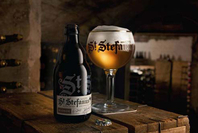Sint Stefanus, Van Steenberge
Added: Thursday, August 1st 2019
| Style | Abbey | ABV 7.0% |
Van Steenberge Sint Stefanus Blonde 7%
The beer is the result of collaboration between an independent Belgian family brewery and an abbey in Ghent. The brewery started life on a farm at Ertvelde in the 1820s. It grew in size and influence in the 20th century under the guidance of Paul Van Steenberge, a leading figure in Belgian life. He served as a mayor and entered the national parliament as an advocate of the Flemish cause. He went on to found a Flemish university in Ghent.
His main beer was in the Oud Bruin – Old Brown – style but with the growth of lager after World War Two the brewery launched its own Pils. It found it hard to compete with such major brands as Stella Artois and the family decided to revert to ale.
As Trappist beers grew in popularity, Van Steenberge opened talks with the Augustinian monks at Sint Stefanus monastery in Ghent. The monks had made their own beer for centuries but depleted numbers of their flock forced them to stop production in the 1970s.
But they were keen to have a beer brewed for them. In 1978 Van Steenberge launched a beer in bottle and on draught called Augustijn, with royalties made to the monks. The beer is still sold by that name in Belgium but in 2012 it was rebranded Sint Stefanus for export.
Jef Versele, the brewery’s sales manager and a member of the Van Steenberge family, says the monks insisted that the beer should be re-fermented in the bottle. They handed over their recipe, and crucially, the yeast culture. In total, three yeast strains are used to make the beer, which is re-fermented in both bottle and keg. It’s made with pale, Pilsner and Munich malts with a small amount of brewing sugar. The main hop is Saaz with the addition of some German Hallertau. The brewery uses hard water that’s filtered and then Burtonised with sulphates.
At the end of primary fermentation, some yeast is removed by centrifuge but sufficient remains for a four-week maturation at 2 degrees C. The original yeast is then filtered out and two new strains, including Brettanomyces, added. Brett is best known as the catalyst used to make lambic and gueuze beers. Bottles are stored at 24 degrees for two weeks, allowing for secondary fermentation to take place. The bottles are then moved to a cellar for a minimum of three months before they are released.
Jef Versele says the beer will improve in bottle for three years. For the keg version, he says a careful measure of sugar is used to avoid the containers exploding. Van Steenberge is one of few Belgian breweries to condition beer in keg.
At six weeks the pale gold beer in bottle has a big spicy and peppery hop aroma with tangerine fruit, a creamy malt note and a hint of “horse blanket” from the Brett. Tart hops and tangy fruit fill the mouth, balanced by creamy malt and a hint of sourness. The finish is dry, with tangy hop resins, tangerine fruit and rich malt. At six months, the fruit character is more pronounced, with a big spicy hop note and more restrained malt. Bitter hops and tart fruit dominate the palate while creamy malt builds in the finish with bitter hops and tangy fruit.
•Waitrose/Ocado £2.99. Also available from www.beerhawk.co.uk and www.belgiumabox.com







